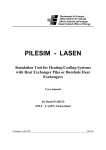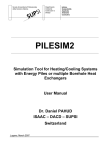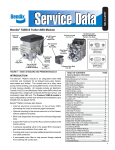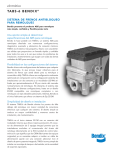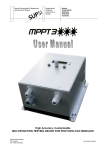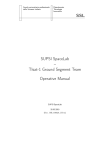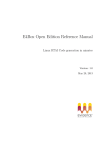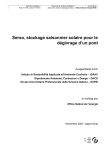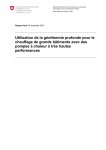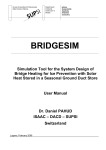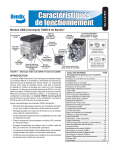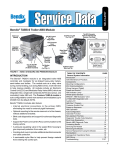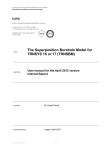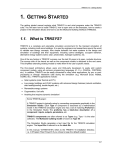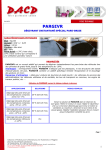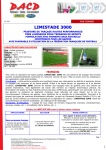Download "user manual"
Transcript
Scuola Universitaria Professionale della Svizzera Italiana Dipartimento Ambiente Costruzioni e Design Istituto Sostenibilità Applicata Ambiente Costrutivo COOLSIM Simulation Tool for the System Design of Borehole Heat Exchangers or Energy Piles for Geocooling with TABS in Office Building User Manual Dr. Daniel PAHUD ISAAC – DACD – SUPSI Switzerland Lugano, November 2008 SUPSI – DACD – ISAAC page 2 Table of content 1. PC and System Requirement ......................................................................................... 3 2. Installation Procedure .................................................................................................... 3 3. How to Start COOLSIM ................................................................................................... 4 4. Limitation of the Technical Support ............................................................................... 4 5. The COOLSIM Simulation Tool ....................................................................................... 5 5.1. Introduction ..................................................................................................................... 5 5.2. COOLSIM System Border ................................................................................................ 5 5.3. TABSIM System Border ................................................................................................... 6 5.4. COOLSIM System Simulation Tool .................................................................................... 6 5.5. Input Data to COOLSIM ................................................................................................... 6 5.6. How to Run COOLSIM ................................................................................................... 23 5.7. Output Data from COOLSIM ........................................................................................... 25 5.8. Output Results with COOLSIM ........................................................................................ 34 6. Input parameters for the building ................................................................................. 40 6.1. Introduction ................................................................................................................... 40 6.2. Input variables ............................................................................................................... 40 6.3. Output variables ............................................................................................................ 41 7. References .................................................................................................................. 42 8. SEL, TESS and TRANSSOLAR TRNSYS distributors .................................................... 42 9. Acknowledgements ..................................................................................................... 42 COOLSIM user manual SUPSI – DACD – ISAAC 1. page 3 PC and System Requirement COOLSIM was tested on a laptop (Pentium 1.7 GHz and 512 MBytes of RAM) with Windows XP Professional. COOLSIM requires about 100 to 200 MBytes of hard disk space. COOLSIM is a 32 bits programme and is not working with Windows 3.x. COOLSIM is a TRANSED application of the TRNSYS package simulation tool made with the TRNSYS version 16.1. 2. Installation Procedure All the necessary files are compressed in a single zipped file. To install COOLSIM, you may start the programme Windows Explorer and select the drive and directory where the compressed file is (e. g. select the drive C:\MySavedFiles), provided you have saved the COOLSIM zipped file in this directory. You may also click on the My Computer icon in order to find the drive and directory where the file is stored. To install COOLSIM, you have to create a directory on your local hard drive. It is recommended to created a new directory, for example C:\COOLSIM, without space characters in the name and path name, and copy in this directory the COOLSIM.ZIP file. Unzip the file and be sure that the subdirectory structure is maintained. (If you already have TRNSYS on your computer, it is not advised to install COOLSIM in the same directory. Several of your original TRNSYS files would be overwritten and lost). To remove COOLSIM from your computer, simply delete the directory in which COOLSIM was installed. One additional utility is distributed in an Excel file which requires the EXCEL programme to be used. This is: - “Coolsim.xls”: this file is devised to visualise the results of a simulation contained in the various output files produced with COOLSIM. This file is stored in the “CoolSimResults” subdirectory. COOLSIM user manual SUPSI – DACD – ISAAC 3. page 4 How to Start COOLSIM With Windows there are different ways of starting COOLSIM. COOLSIM is started by running the executable file COOLSIM.EXE. It is important to run the COOLSIM.EXE file from the directory where COOLSIM is installed. It is recommended to create on the desktop a shortcut to the COOLSIM.EXE file. To do this, search with Windows Explorer the directory in which COOLSIM has been installed. Search the executable file COOLSIM.EXE. Select the file COOLSIM.EXE with the mouse and right click on it. A context sensitive menu appears. Choose “Send to” and select “Desktop” to send the shortcut on the desktop. You can then rename the shortcut to “COOLSIM”. When COOLSIM is started (i.e. when the programme COOLSIM.EXE from the COOLSIM directory is executed), the input file COOLSIM.TRD is opened. If you would like to work with the TABSIM.TRD input file, close COOLSIM.TRD and open TABSIM.TRD. To check that COOLSIM is working properly, run the input file COOLSIM.TRD with the default parameter values. To start the calculation, choose TRNSYS / Calculate in the menu. The calculated results are stored in several files (COOLSIM.PAR, COOLSIM.EXT, COOLSIM.OU1, COOLSIM.OU2, COOLSIM.OU3, COOLSIM.OU4, COOLSIM.OU5, COOLSIM.OU6, COOLSIM.OU7, COOLSIM.OU8, COOLSIM.OU9, COOLSIM.PL1, COOLSIM.PL2, COOLSIM.LST and DST.DAT). They should be the same as the output results stored in the directory COOLSIMRESULTS. An original copy of COOLSIM.TRD is also stored in this directory. 4. Limitation of the Technical Support At the moment COOLSIM is not for sale ! COOLSIM user manual SUPSI – DACD – ISAAC 5. page 5 The COOLSIM Simulation Tool 5.1. Introduction The COOLSIM simulation tool is devised for the simulation of office buildings heated with a heat pump coupled to a borehole field or energy piles, and cooled with these latter by geocooling. No hot water is covered by the system. The energy concept involves a heat pump directly coupled to active concrete plates or floor heating, which are also used for cooling. No cooling and dehumidification is simulated in the building ventilation system. The COOLSIM simulation tool has been developed on the basis of the PILESIM2 simulation tool (PAHUD, 2007). 5.2. COOLSIM System Border The delimitation of the simulated system is shown by the system border in figure 5.1. System border Heated / cooled building Heat distribution Cellar Cold distribution Heat pump Ground layer 1 Ground layer 2 Energy piles or borehole heat exchangers Ground layer 3 Figure 5.1 System simulated by the COOLSIM tool. COOLSIM user manual SUPSI – DACD – ISAAC page 6 5.3. TABSIM System Border In a first step, the determination of the heating and cooling requirements of the building is performed with the TABSIM interface. The geothermal system is excluded from the simulation. The delimitation of the system part simulated with TABSIM is shown in figure 5.2. System border for the determination of heating and cooling parameters (TabSim) Heated / cooled building Heat distribution Cellar Cold distribution Heat pump Ground layer 1 Ground layer 2 Energy piles or borehole heat exchangers Ground layer 3 Figure 5.2 System part simulated by the TABSIM tool. 5.4. COOLSIM System Simulation Tool The use of COOLSIM requires to define first the heating and cooling requirements of the building. Heating power and cooling temperature have to be adjusted together with set point temperatures and controls, so that thermal comfort is ensured with minimum energy requirements. The tool TABSIM has been devised for this purpose. It is a simplified version of COOLSIM. The input data to TABSIM are the same as those for COOLSIM, except for the non necessary components, such as the geothermal system. In the next section, input data to COOLSIM are listed and defined. 5.5. Input Data to COOLSIM The input data to COOLSIM concern all the information that can be varied by the user. In particular, the input data define the size and characteristics of the different parts of the system and the driving conditions which will condition the operation of the system. In this chapter, each parameter required to COOLSIM is described and explained. COOLSIM user manual SUPSI – DACD – ISAAC page 7 The input data are grouped in 6 blocks: • Simulation and location • Building • Heating and cooling • Interface ground-building • Ground heat exchanger • Ground characteristics The TABSIM tool, used to determine the building control, heating and cooling requirements, only requires the input data of the three blocks “Simulation and location”, “Building” and “Heating and cooling”. COOLSIM and TABSIM are TRNSED applications. The input parameter values may either be given in the “primary units”, which correspond to the unit assumed by TRNSYS, or in the “secondary units”, which are more convenient units for the user. For example, the primary unit of thermal conductivity is [kJ/(h m K)], whereas the secondary unit is [W/(mK)]. All the units given in the following sections for the input parameters correspond to the “secondary units”. When COOLSIM or TABSIM is used, it is highly recommended to set the units on “secondary”. This is done by selecting Secondary Units in the menu TRNSYS of the TRNSED application. 5.5.1. Simulation and location The entries are grouped in three blocks: Simulation parameters: Month for simulation start: the simulation starts the first day of the chosen month. Length of simulation: duration of the simulation period. The maximum duration is limited to 50 years. Time interval for output results: quantities can be calculated on a monthly basis or a yearly basis. They are integrated heat rates or average values. See chapter 5.6 for a complete description of the output results. Print hourly values for last year: this parameter determines if the hourly values of some selected quantities are written (yes) or not (no) for the last operational year (see chapter 5.6 for more details). Online plotter: Check the box to plot thermal powers and fluid temperatures of the ground heat system during simulation. COOLSIM user manual SUPSI – DACD – ISAAC page 8 Location parameters: Meteorological data for location: choose from the list the location of the project. This choice determines the weather data file that will be used for the simulation. If you would like to add more locations, you have to create a weather file with Meteonorm and update the file LocationList.txt in the Weather subdirectory. Please follow the indications given in this file. Latitude, longitude and altitude of location: choose from the list the same location of the previous one used for the meteorological data. This choice sets the latitude, longitude and altitude of the location. 5.5.2. Building The entries are grouped in two blocks: Building parameters: Data file for building description: choose from the list the building name to be simulated. This choice determines the building data file that defines the building thermal parameters. If you would like to add more buildings, you have to define them with TRNBuild of the TRNSYS package and update the file BuildingList.txt in the Building subdirectory. Please follow the indications given in this file. Surface values for building data file: choose from the list the same building name as the previous one. This choice sets various surface areas. They are: - SRE: heated/cooled reference area of building (zone 1 and 2) [m2] - Stabs3: area of the fictive zone 3 used for the simulation of TABS3 [m2] - Stabs4: area of the fictive zone 4 used for the simulation of TABS4 [m2] - Stabs5: area of the fictive zone 5 used for the simulation of TABS5 [m2] - Stabs6: area of the fictive zone 6 used for the simulation of TABS6 [m2] The total area of the TABS in the building is given by the sum of the areas of the 4 fictive zones. These latter are stored in the file BuildingList.txt and must correspond to the building description file. Please follow the indications given in this file for any modification. Azimuth of south-west façade [AzimSudWest]: azimuth of the south-west façade [°]. Should be comprised between 0° and 90°. All the 4 façades are supposed to be at right angle, forming thus a rectangular shape. Scaling factor for internal heat gains [ScaleGainInt]: scaling factor for internal heat gains [-]. The daily and weekly profile of the internal heat gains are defined in the building definition file. This scaling factor enable to amplify them with a constant factor. Air change rate for night cooling [ACRnight]: air change rate for nocturnal ventilation when the building is cooled during Summer. A typical value is an air change rate of 2 [h-1]. COOLSIM user manual SUPSI – DACD – ISAAC page 9 Nominal air change rate of mechanical system ventilation [ACRmechanic]: nominal air change rate of the mechanical system ventilation [h-1]. The mechanical system ventilation is operating according to daily and weekly schedules. When the ventilation system is operating, this parameter defines the ventilation air change rate. Efficiency of the mechanical system heat recovery units [AirHXEfficiency]: nominal efficiency of the mechanical system heat recovery units [-]. The heat recovery units of the mechanical ventilation system are simulated with a constant heat exchanger efficiency. A typical value is an efficiency of 0.8 [-] Specific flow rate in TABS [FlowSpecTABS]: specific flow rate in tabs [(kg/h)/m2]. It is the total flow rate through the TABS divided by the total area of the concrete active plates; (it is the area of all the internal concrete plates equipped with pipes). Thermal resistance fluid-concrete in TABS [RTABS]: thermal resistance between the fluid circulating in the pipes and the concrete in the plane of the pipes [K/(W/m2)]. ⎛ ⎛δ ⎞ 1 1 1 ⎛ l RTABS = l ⎜ + ln⎜ ⎟ + ln⎜ ⎜ π λ f Nu 2 π λ p ⎜ δ pi ⎟ 2π λ ⎝δ π ⎝ ⎠ ⎝ ⎞ ⎞⎟ ⎟ ⎠ ⎟⎠ (5.1) With : l : distance between pipes in the concrete plates (typical distance = 0.15 [m] ) (TABS); λf : thermal conductivity of the fluid circulating in the pipes (water = 0.6 [W/mK] ); Nu : Nusselt number for the convective heat transfer between fluid and inner pipe wall. It depends on the fluid flow regime (laminar, Nu = 4.36 [-] ); λp : thermal conductivity of the pipe material (plastic pipe in polyethylene: 0.4 [W/mK] ); λ : concrete plate thermal conductivity (concrete : 1.8 [W/mK] ); δ : external pipe diameter (typical diameter = 0.02 [m] ); δpi : internal pipe diameter (typical diameter = 0.016 [m] ); RTABS : thermal resistance between the fluid temperature and mean concrete temperature in the pipe plane (RTABS is calculated to 0.043 [K/(W/m2)] with above parameters); The validity of equation (5.1) is guaranteed if the following two conditions are met : di / l > 0.3 , i = 1 and 2 δ / l < 0.2 d1+d2 : concrete plate thickness [m] ; d1 : thickness of concrete plate layer lying over the pipe plane [m] ; d2 : thickness of concrete plate layer lying under the pipe plane [m] . COOLSIM user manual (5.2) (5.3) SUPSI – DACD – ISAAC page 10 Building control parameters: Daily temperature limit for Winter [TlimitWinter]: daily outdoor air temperature limit under which heat recovery on the ventilation system is performed [°C]. The running mean outdoor air temperature, defined according to the standard DIN EN 15251, is chosen for the daily outdoor air temperature. It has no direct influence on the heating control of the building. Daily temperature limit for Sommer [TlimitSommer]: daily outdoor air temperature limit over which cooling is allowed [°C]. The running mean outdoor air temperature, defined according to the standard DIN EN 15251, is chosen for the daily outdoor air temperature. This temperature condition has to be met to enable the cooling control of the building and nocturnal cooling with the ventilation system. It is used to determine the duration of the cooling period. The remaining time of the year is the winter use duration. In any case cooling is only allowed if no heating requirement is requested. In practice heating and cooling conflict never happens as it is requested that the indoor air temperature limit to switch off cooling (TSetCoolingLow) is larger than that to switch off heating (TSetHeatingHigh). Set point temperature to switch on heating [TSetHeatingLow]: indoor air temperature limit under which heating is switched on [°C]. Set point temperature to switch off heating [TSetHeatingHigh]: indoor air temperature limit over which heating is switched off [°C]. This temperature limit has to be larger than TSetHeatingLow, used to switch on heating. Set point temperature to switch on cooling [TSetCoolingHigh]: indoor air temperature limit over which cooling is switched on [°C]. Set point temperature to switch off cooling [TSetCoolingLow]: indoor air temperature limit under which cooling is switched off [°C]. This temperature limit has to be smaller than TSetCoolingHigh, used to switch on cooling. 5.5.3. Heating and cooling The entries are grouped in various blocks: Heat pump power and efficiency: Design thermal power of the heat pump [PHeatDesign]: design (or nominal) thermal power delivered at the condenser of the heat pump (PAC). It is the heating power delivered by the heat pump at nominal temperature conditions in evaporator and condenser [kW]. Design performance coefficient [COPo]: the design performance coefficient is the performance coefficient of the heat pump when the inlet fluid temperature in the evaporator and the outlet fluid temperature from the condenser are at their design values [-]. The design performance coefficient is expressed by relation (5.4): COOLSIM user manual SUPSI – DACD – ISAAC page 11 COPo = PHeatDesign / Pel PHeatDesign: Pel: (5.4) design heating power delivered by the heat pump. design electric power absorbed by the compressor of the heat pump. The design electric power of the heat pump is assumed to be constant even when the heat pump performance coefficient is calculated in function of the temperature levels in evaporator and condenser. Heat pump COP: Constant or variable COP during simulation: check the box according to the desired choice. With the constant COP choice the performance coefficient is kept constant and set to its design value (COPo). With the variable COP choice the performance coefficient is free to vary according to operating conditions. If the variable COP box is checked, the next parameter block “Heat pump COP dependencies” has to be filled in. Otherwise this block of parameters is not shown. Heat pump COP dependencies: The parameters for the heat pump COP dependencies refer to the heat pump model described in chapter 7 of the PILESIM2 user manual (Pahud, 2007). They only have to be entered if the variable COP option has been checked. Design inlet fluid temperature in evaporator for COPo: design inlet fluid temperature in the evaporator that leads to the design performance coefficient (COPo) of the heat pump [°C]. Design outlet fluid temperature from condenser for COPo: design outlet fluid temperature from the condenser that leads to the design performance coefficient (COPo) of the heat pump [°C]. Temperature difference for COP reduction: parameter dTCOP for the heat pump model [K]. Temperature difference for COP stagnation: parameter dTstag for the heat pump model [K]. Maximum possible COP: maximum value that the heat pump performance coefficient (COP) may have [-]. Penalty on the COP: penalty on the performance coefficient [-]. This value is subtracted from the calculated value, so that transient effects, bad control of the heat pump or something else, can be artificially taken into account. Typical values are comprised between 0 and 0.5. COOLSIM user manual SUPSI – DACD – ISAAC page 12 Heat pump temperature difference: Design inlet-outlet temperature difference in evaporator (PAC): design temperature drop between inlet and outlet fluid that crosses the heat pump evaporator [K]. Together with the heat power extracted under design conditions, this temperature drop determines the flow rate through the evaporator. This flow rate is also the total flow rate in the flow circuit of the borehole heat exchangers or the energy piles when the heat pump is operating. It is called the heating flow rate. When the operating mode is geocooling, the flow rate through the pile flow circuit is equal to that in the cooling distribution of the building, even if a heat exchanger is physically decoupling hydraulically the two flow circuits. Design inlet-outlet temperature difference in condenser (PAC): design temperature drop between inlet and outlet fluid that crosses the heat pump condenser [K]. This temperature difference, together with the design thermal power of the heat pump, is determining the fluid flow rate through the heat pump condenser. It is important that the flow rate through the heat distribution system (TABS or else) is not smaller than the flow rate through the heat pump condenser. If it is the case, the flow rate in the distribution system is set to the heat pump condenser flow rate when heating is performed. Temperature limitation: Minimum allowed temperature of the heat carrier fluid in the piles/boreholes [TfMin]: minimum tolerated fluid temperature in the bores/piles hydraulic circuit [°C]. This value may limit the heat rate that is extracted from the ground, as the simulated inlet fluid temperature in the bores / piles is limited by this value. This constraint limits the size of the heat pump or the total length of the borehole heat exchangers, as a normal system operation should never lead to a fluid temperature below this limit. Geocooling: Design forward fluid temperature for cooling [TCoolDesign]: design forward fluid temperature for cooling [°C]. This value is assumed to be constant all through the year. If the outlet fluid temperature from the ground heat exchanger is low enough to guarantee this forward fluid temperature (taking into account the counter flow heat exchanger between the cooling distribution and the ground flow loop), then the cooling requirement is met. The forward fluid temperature in the cooling distribution is fixed to the design one (TCoolDesign). If the resulting temperature lies between the design forward one and the return fluid temperature from the cooling distribution, then only a fraction of the cooling demand is met. If the resulting temperature is larger than the return one from the cooling distribution, geocooling is not possible and stopped. In this case the cooling demand is not satisfied. No backup cooling energy is provided in the building. It will result a larger indoor air temperature and a lesser thermal comfort in the building. COOLSIM user manual SUPSI – DACD – ISAAC page 13 Design heat transfer coefficient of geocooling counterflow heat exchanger [HXUAGEO]: design heat transfer coefficient of the counterflow heat exchanger between the cooling distribution and the ground flow loop [kW/K]. If no heat exchanger is present, this parameter can be fixed to an arbitrary large value (for example 1025 kW/K). 5.5.4. Interface ground-building The entries are grouped in the following block: Location of the ground heat exchanger: Under or outside of the building: check the box according to the desired choice. If the box “energy piles, borehole heat exchangers under the building” is checked, the entries of the block “Interface ground heat exchanger-building” are shown and have to be filled in. In the contrary, if the box “borehole heat exchangers outside of the building” is checked, the entries of the box “Interface building-ground and ground heat exchanger-garage/outside” are shown and have to be filled in. Interface ground heat exchanger-building: These entries are shown only if the box “energy piles, borehole heat exchangers under the building” is checked. Height of the cellar between rooms and ground [Hfloor]: height of the cellar that lies between the ground and the heated rooms [m]. This parameter is used to estimated the air volume of the cellar for air change losses. The cellar volume is calculated with the cellar floor area (see equation 5.7). Air change rate in the cellar [ACRcellar]: this air change rate determines the heat losses or gains with the outdoor air [h-1]. For the sake of simplicity, the losses from the cellar to the exterior (outdoor air) are only computed by ventilation losses. Thus the specific heat losses from the cellar to the exterior (Uce) are established with formula 5.5. Uce (kJ/hK) = Cellar_floor_area (m2) x Cellar_height (m) x 1.2 (kJ/m3K) x Cellar_air_change rate (1/h) Uce (W/K) = Uce (kJ/hK) x 1000 (J/kJ) / 3600 (s/h) (5.5) (5.6) The Cellar_air_change_rate is ACRcellar (label of this parameter), the Cellar_height is Hfloor (label of the previous parameter) and the Cellar_floor_area, supposed to be delimited by the area occupied by the energy piles or boreholes, is calculated with relation 5.7. Cellar_floor_area = BPILE x BPILE x PileNumber (5.7) BPILE is the average spacing between the piles (see below Average spacing between the piles); PileNumber is the total number of energy piles or boreholes. Heated / cooled zone in contact with the ground: COOLSIM user manual SUPSI – DACD – ISAAC page 14 If the heated or cooled zone (having a room air temperature given by the indoor air temperature simulated for the building), is in close contact with the bore/pile field (no cellar), set parameter ACRcellar to zero: ACRcellar = 0 [h-1] The room-cellar specific heat losses should have a large value but must be in any case compatible with the building elements that separate the heated zone from the non heated space in contact with the ground. They are defined in the building definition file (see next parameter for more details). Total room-cellar specific heat losses of the selected building: total specific heat losses of the building to the cellar that has been selected in block “Building parameters” of section “Building” [W/K]. If, for example, there are two building elements in contact with the cellar, having respectively for U-values and areas: U1, S1, U2 and S2, the specific heat losses to the cellar are, without air convective heat transfer between the heated building and cellar: Ucm (W/K) = S1 (m2) x U1 (W/m2K) + S2 (m2) x U2 (W/m2K) (5.8) With U1 = 0.29 W/(m2K), S1 = 323 m2 and U2 = 0.296 W/(m2K), S2 = 118 m2, the specific heat losses are: Ucm = 128.6 W/K Insulation thickness between ground and cellar [Hinsul]: the insulation thickness between the ground and the cellar determines the thickness of the insulation layer that lies between the cellar and the ground [m]. A thermal conductivity of 0.05 W/mK is assumed for the insulation material. The horizontal pipes that connect the heat exchanger piles to the pipe collectors are supposed to lie below the insulation layer. A different thermal conductivity for the insulation material (for "New_lambda_insulation" W/mK) can be taken into account by using formula 5.9. Hinsul = Hinsul_actual x 0.05 (W/mK) / New_lambda_insulation (W/mK) example (5.9) Where Hinsul_actual is the actual thickness of the insulation layer. Concrete thickness between ground and cellar [Hmagco]: the concrete thickness between the ground and the cellar determines the thickness of the concrete plate that lies between the cellar and the ground [m]. A thermal conductivity of 1.3 W/mK is assumed for this concrete. The horizontal pipes that connect the heat exchanger piles to the pipe collectors are supposed to lie below the concrete plate. A different thermal conductivity for the concrete (for example "New_lambda_concrete" W/mK) can be taken into account by using formula 5.10. Hmagco = Hmagco_actual x 1.3 (W/mK) / New_lambda_concrete Where Hmagco_actual is the actual thickness of the concrete plate. COOLSIM user manual (W/mK) (5.10) SUPSI – DACD – ISAAC page 15 Length of the horizontal connecting pipes on ground heat exchanger [LCOEPF]: the length of the horizontal pipes on ground is the effective pipe length that connects the bores or piles to the main pipe collectors [m]. This parameter is used for the determination of the heat transfer that occurs between the fluid in these pipes and the ground in the plane of the pipes. The pipes are supposed to lie below the concrete plate and the insulation layer if any. The calculation assumes a uniform density of horizontal pipes in the interface ground - cellar. In reality this is not the case and a rough approximation is to set this parameter to half of the total horizontal pipe length. The influence of the horizontal pipes on ground is not taken into account if LCOEPF is set to zero. The heat transfer coefficient of the horizontal pipes is calculated with an approximation developed by Koschenz and Dorer (1996). See formulas 5.11 and 5.12. ECARCO (m) = Cellar_floor_area (m2) / LCOEPF (m) (5.11) ECARCO is the average distance between the horizontal pipes on ground and the Cellar_floor_area is defined by formula 5.7. LCOEPF is the label for the length of the horizontal pipes on ground. The heat transfer coefficient from the fluid in the pipes to the ground in the plane of the pipes, UPipeCo, is given by two thermal resistances in series (see relation 5.12). UPipeCo (W/m2K) = 1 ⎛ ⎛ ECARCO ⎞ ⎞ 1 ⎟⎟ ⎟⎟ ECARCO ⎜⎜ Rfluid_pipe + ln⎜⎜ 2 g o _ pipe π λ π φ ⎝ ⎠⎠ ⎝ (5.12) Rfluid_pipe (K/(W/m)) is the thermal resistance between the fluid and the outer side of the pipe wall. This resistance is arbitrarily fixed to 0.272 K/(W/m). The second term in the parenthesis of relation 5.12 is the thermal resistance from the outer pipe wall to the average temperature of the ground in the plane of the pipes. The thermal conductivity of the ground in the pipe plane, is denoted λg, is fixed to 1.3 W/mK. The outer diameter of the pipe is φo_pipe and fixed to 32mm. Interface building-ground and ground heat exchanger-garage/outside: These entries are shown only if the box “borehole heat exchangers outside of the building” is checked. Air temperature in building cellar [TairCellar]: air temperature in the cellar [°C]. This air temperature is constant and given as input to the building simulation model. Constant air temperature component of garage [TconstGarage]: constant temperature component assigned to the garage that lies over the borehole heat exchangers [°C]. The air temperature in the garage will result from the heat transfer from this constant temperature and the corresponding heat transfer coefficient UCelBu (see parameter below), heat transfer with the outside air, calculated with a constant air change rate ACRcellar, and heat transfer with the ground (top side of the ground volume enclosed by the ground heat exchanger). If no garage is present on top of the ground heat exchanger, UCelBu can be fixed to zero and ACRcellar to an arbitrary large value (see parameter ACRcellar below), so that the garage temperature is equal to the outside air temperature. COOLSIM user manual SUPSI – DACD – ISAAC page 16 Height of the garage above the ground heat exchanger [Hfloor]: height of the garage that lies above the ground heat exchanger [m]. This parameter is used to estimated the air volume of the garage for air change losses. The volume is calculated with the cellar floor area (see equation 5.7). Air change rate in garage [ACRcellar]: this air change rate determines heat losses or heat gains in the garage with the outdoor air [h-1]. For the sake of simplicity, the losses from the garage to the exterior (outdoor air) are only computed by ventilation losses. The specific heat losses from the garage to the exterior (Uce) are calculated using formula 5.5 and 5.6. No garage above the ground heat exchanger: If there is no garage above the ground heat exchanger, the air temperature of the “missing” garage should be equal to that of the outside air. This is possible by setting the parameters ACRcellar and UCelBU (next parameter) to the following values : ACRcellar = 1025 [h-1] (and the parameter Hfloor has to be greater than 0) UCelBu = 0 [W/m2K] Heat transfer coefficient with constant air temperature component of garage [UCelBu]: heat transfer coefficient between the constant temperature component of the garage and its resulting air temperature. The heat transfer is calculated with the specific losses coefficient Ucm. This latter is obtained with formula 5.13. Ucm (W/K) = Cellar_floor_area (m2) x UCelBu (W/m2K) (5.13) See formula 5.7 for the calculation of Cellar_floor_area. No garage above the ground heat exchanger: If there is no garage above the ground heat exchanger, the air temperature of the “missing” garage should be equal to that of the outside air. This is possible by setting the parameters ACRcellar (previous parameter) and UCelBU to the following values : ACRcellar = 1025 [h-1] (and the parameter Hfloor has to be greater than 0) UCelBu = 0 [W/m2K] Insulation thickness between ground and garage [Hinsul]: the insulation thickness between the ground and the garage determines the thickness of the insulation layer that lies between the cellar and the ground. A thermal conductivity of 0.05 W/mK is assumed for the insulation material. The horizontal pipes that connect the bores or piles to the main pipe collectors are supposed to lie below the insulation layer. A different thermal conductivity for the insulation material (for example "New_lambda_insulation" W/mK) can be taken into account by using formula 5.9. Concrete thickness between ground and garage [Hmagco]: the concrete thickness between ground and garage determines the thickness of the concrete plate that lies between the ground and garage. A thermal conductivity of 1.3 W/mK is assumed for concrete. The horizontal pipes that connect the borehole heat exchangers to the main pipe collectors are supposed to lie below the concrete plate. A different thermal conductivity for concrete (for example "New_lambda_concrete" W/mK) can be taken into account by using formula 5.10. COOLSIM user manual SUPSI – DACD – ISAAC page 17 Length of the horizontal pipes on ground [LCOEPF]: the length of the horizontal pipes on ground is the effective pipe length that connects the borehole heat exchangers to the main pipe collectors. This parameter is used for the determination of the heat transfer that occurs between the fluid in these pipes and the ground in the plane of the pipes. The pipes are supposed to lie below the concrete plate and the insulation layer if any. The calculation assumes a uniform density of horizontal pipes in the interface ground - garage. In reality this is not the case and a rough approximation is to set this parameter to half of the total horizontal pipe length. The influence of the horizontal pipes on ground is not taken into account if LCOEPF is set to zero. The heat transfer coefficient of the horizontal pipes is calculated with formulas 5.11 and 5.12. 5.5.5. Ground heat exchanger The entries are grouped in the following block: Energy piles or borehole heat exchangers: Up to 6 different pile/bore types can be specified. A pile/bore type is defined by its diameter, thermal resistance and average active pile/bore length. Average values are calculated from these quantities, as only one pile/bore type is simulated. Diameter of pile/borehole type i (i = 1 [dp1], 2, 3, 4, 5 or 6). This parameter determines the diameter of pile/bore type i [m]. The average pile/bore diameter is calculated so that the total volume of piles/bores is preserved (see relation 5.14). It is written in the output parameter file with the extension ".PAR" (parameter label: AvePilDiam). 1 ⎛ 6 ⎞2 2 ⎜ ∑ (dpi/2 ) Hi Ni ⎟ ⎟ AvePilDiam = 2 ⎜ i =1 6 ⎜ ⎟ Hi Ni ⎜ ⎟ ∑ i =1 ⎝ ⎠ (5.14) dpi is the pile/bore diameter of type i, Hi the pile/bore active length and Ni the pile/bore number (see below). Number of piles/boreholes for type i (i = 1 [N1], 2, 3, 4, 5 or 6). This parameter determines the number of piles/bores of type i [-]. The total number of energy piles or boreholes is the sum of each pile/bore type number (see 5.15) and is written in the output parameter file with the extension ".PAR" (parameter label: PileNumber). 6 PileNumber = ∑ Ni (5.15) i =1 Average active length of piles/boreholes type i (i = 1 [H1], 2, 3, 4, 5 or 6). This parameter determines the average active pile length of pile type i [m]. The active length of a pile is defined by the pile length for which a radial heat transfer with the ground may occur. In other terms, it is the length of the pile that is equipped with pipes. The pile active length is smaller than the total pile length. An average active pile length is calculated for ALL the heat exchanger piles (see formula 5.16). It defines the vertical extension of the ground volume that contains the simulated piles. It is written in the output parameter file with the extension ".PAR" (parameter label: AvePLength). COOLSIM user manual SUPSI – DACD – ISAAC page 18 6 ∑ Ni Hi AvePLength = i =1 (5.16) 6 ∑ Ni i =1 Thermal resistance Rb of pile/borehole type i (i = 1 [Rb1], 2, 3, 4, 5 or 6). This parameter determines the thermal resistance of pile/bore type i [K/(W/m)]. The thermal resistance of a pile/borehole determines the temperature difference between the fluid and the ground in the immediate vicinity of the pile/borehole under a given heat transfer rate. For example, a thermal resistance value of 0.1 K/(W/m) will induce a temperature difference of 5 K between the fluid temperature and the ground temperature at the pile/bore border, when a heat transfer rate of 50 W/m takes place in steady flux conditions in the pile/bore. For more information on pile thermal resistances, see Fromentin et al., 1997. For borehole thermal resistances, the use of the programme EED (Earth Energy Designer) is recommended (Hellström and Sanner, 1994). In EED, a tool for the calculation of borehole thermal resistances with single, double, triple U-pipe or coaxial pipes is integrated. Other pipe configurations in a borehole or a pile can be treated with the programme MPC (Bennet et al., 1987). Some thermal resistance values are given below. Energy pile thermal resistances: 0.15 K/(W/m) hollow prefabricated pile with a double U-pipe, pile diameter: 30 to 50 cm; 0.10 - 0.11 K/(W/m) pre-cast or cast in place pile, double U-pipe fixed on the metallic reinforcement. Pile diameter: 30 to 150 cm; 0.07 - 0.08 K/(W/m) pre-cast or cast in place pile, triple U-pipe fixed on the metallic reinforcement. Pile diameter: 30 to 150 cm; 0.06 K/(W/m) pre-cast or cast in place pile, quadruple U-pipe fixed on the metallic reinforcement. Pile diameter: 30 to 150 cm; Borehole thermal resistances: A typical value of 0.1 K/(W/m) is representative for a double U-pipe in a borehole of diameter 10 to 15 cm. An average pile/bore thermal resistance is calculated for ALL the energy piles/boreholes with the help of formula 5.17. The average pile/bore thermal resistance is calculated relatively to the average pile diameter (AvePilDiam). It is written in the output parameter file with the extension ".PAR" (parameter label: AveRbPile). ⎧ ⎪ 6 6 1 1 ⎪ Hi Ni = ∑ ⎨Hi Ni ∑ AveRbPile ⎛ ⎛ AvePilDiam ⎞ ⎞ 1 i =1 i =1 ⎪ ⎜ Rbi + ⎜⎜ ⎟⎟ ⎟⎟ ln ⎜ ⎪ π λ i 2 avegr dp ⎝ ⎠⎠ ⎝ ⎩ ⎫ ⎪ ⎪ ⎬ ⎪ ⎪ ⎭ (5.17) λavegr is the average ground thermal conductivity. This value takes into account the thermal conductivity of each ground layer which is crossed by the average active pile/bore length (AvePLength). It also takes into account the influence of a regional ground water flow by using COOLSIM user manual SUPSI – DACD – ISAAC page 19 the correction factor applied on the thermal conductivity (see section 7.2 of PILESIM2 user manual). Internal thermal resistance Ra of pile/borehole type i (i = 1 [Ra1], 2, 3, 4, 5 or 6). This parameter determines the internal thermal resistance of the piles/boreholes [K/(W/m)]. The internal thermal resistance of a pile/bore determines the internal heat transfers within the pile/bore. A typical value is comprised between 0.1 - 0.4 K/(W/m) for a double U-pipe in a borehole heat exchanger. Average spacing between the piles/boreholes [BPILE]: this parameter specifies the effective average spacing of ALL the piles/boreholes in the TWO spatial directions of the ground area that contains the piles/boreholes [m]. This parameter determines the ground volume (GrndVolume) that is ascribed to the piles/boreholes with relation 5.18. GrndVolume = (BPILE)2 x PileNumber x AvePLength (5.18) See equations 5.15 and 5.16 for the total number of energy piles/boreholes (PileNumber) and the average active pile/bore length (AvePLength). The average spacing between the piles/bores is called BPILE. The ground volume used for the simulation is written in the output parameter file with the extension ".PAR" (parameter label: GrndVolume). The best pile/bore arrangement for increased thermal performances is obtained with a regular spacing between the piles/boreholes. If the shape of the area occupied by the piles/bores is close to a square, then the average spacing is easy to calculate. A method to establish this parameter is to draw a line around the ground area that is occupied by the piles/boreholes. A "half average spacing" is maintained between the line and the piles/bores in the periphery. The area drawn by this line is then divided by the total number of energy piles/boreholes, and the average spacing is obtained by taking the square root of this number. If the energy piles/boreholes are not uniformly placed within this area, it will result in a smaller average spacing. However, the effective average spacing remains greater than the smallest spacing between two energy piles/boreholes. If the shape of the area that contains the piles/bores is close to a rectangle which is characterised by a large difference between its width and its length, then the average spacing will tend to be greater. As an example, about 200 heat exchanger piles uniformly placed in a rectangular shape of 500m x 30m were simulated. The calibration described below resulted in an increase of the average spacing from 9.3 to 10.1 m, thus less than 10%. A more accurate method is to calibrate the model used in COOLSIM with a model that takes into account the exact position of the piles/bores. It can be done with TRNSBM, the Superposition Borehole Model. Number of piles/boreholes coupled in series [NSERIE]. This parameter determines the number of piles/bores that are connected in series [-]. As the simulation model simulates a cylinder, a radial interconnection of the piles/bores is taken into account. COOLSIM user manual SUPSI – DACD – ISAAC page 20 Pipe configuration in pile/borehole. The two possible pipe configuration in the pile/bore are: U-pipe configuration: the pipe installation in the pile/bore is formed by one or more U-pipes placed close to the circumference of the pile/borehole. Coaxial pipe installation: the pipe installation in the pile/bore is formed by a coaxial pipe. Pipe number in a cross section of a pile/borehole: average number of pipes in a pile/bore cross section [-]. This number is used to estimate the total volume of fluid that is contained in the energy piles/boreholes. This parameter is only used to take into account the heat capacitive effects of the heat carrier fluid in the piles/bores. The total volume of heat carrier fluid contained in the piles is calculated with relation 5.19. Fluid_volume = NTUB x π x (Inner_pipe_radius)2 x PileNumber x AvePLength (5.19) NTUB is the pipe number in a pile/bore cross section; Inner_pipe_radius is defined with the next input parameter (pipe number in a cross section of a pile); PileNumber and AvePLength are respectively the total number and the average active length of the energy piles/boreholes. If Fluid_volume, the volume of heat carrier fluid in the piles/bores, is known, then relation 5.19 can be used to calculate the average number of pipes in a pile/bore cross section. Inner diameter of one pipe: this parameter represents the average inner diameter of the pipes in the energy piles/bores [mm]. It is only used to estimate the total volume of fluid that is contained in the energy piles/boreholes with relation 5.19. The total volume of fluid is only used to take into account the heat capacitive effects of the heat carrier fluid in the piles/bores. Fraction of pile/borehole concrete/filling thermal capacity: this parameter defines the fraction of the pile concrete/bore filling material in the active zone of a pile/bore which contributes to heat capacitive effects [%]. The active zone of a pile/bore is the part that is equipped with plastic pipes for the heat transfer with the ground, i.e. the heat exchanger. A typical value of 50% was found to satisfactorily match measured data of a pile system (pile diameter of 30 to 40 cm). A large value may produce an error which aborts the programme when run. An error message is written in the listing file (COOLSIM.LST). Do not forget to read a possible error message near the end of this file if you can not run your case. If borehole heat exchangers are simulated, the heat capacitive effects are small and a fraction of 0 can be set. The heat capacitive effects of the pile concrete are calculated with an effective pile diameter and an effective pile thermal resistance (see equation 5.20 and 5.21). They are written in the output parameter file with the extension ".PAR" (the parameter labels are respectively: EffPilDiam and EffRbPil). EffPilDiam = AvePilDiam (1 - FrCapa (Cconcr/AveGrndCap) )2 1 (5.20) AvePilDiam is the average pile diameter (see equation 5.14); FrCapa is the fraction of pile thermal capacity taken into account; Cconcr is the volumetric heat capacity of the pile concrete (Cconcr is set to 2’592 kJ/m3K); AveGrndCap is the average volumetric heat capacity of the ground in the zone crossed by the average active pile length. EffRbPile = AveRbPile − COOLSIM user manual 1 ⎛ AvePilDiam ⎞ ln⎜ ⎟ 2 π λ avegr ⎝ EffPilDiam ⎠ (5.21) SUPSI – DACD – ISAAC page 21 AveRbPile is the average pile thermal resistance and λavegr is the average ground thermal conductivity (see equation 5.17). AvePilDiam and EffPilDiam are respectively the average pile diameter and the effective average pile diameter (see equations 5.14 and 5.20). 5.5.6. Ground characteristics The entries are grouped in the following block: Ground characteristics: Up to 3 different horizontal ground layers can be specified. A ground layer is defined by its thickness, the thermal conductivity and volumetric heat capacity of the ground and the Darcy velocity of the water contained in the ground layer. Initial ground temperature [TGRDIN]: this parameter specifies the initial temperature of the ground before the construction of the building [°C]. This temperature should be set to the annual average value of the ground near the surface. A rough estimation is to use the mean annual air temperature at the surface. Mean temperature gradient in the undisturbed ground [dTGRND]: geothermal temperature gradient present at the project location [K/km]. Assumed to be constant, it defines the temperature increase in the ground with depth. Thermal conductivity of ground layer i [LGi] (i = 1, 2 and 3): this parameter sets the thermal conductivity of ground layer i [W/(mK)]. For water saturated soils that requires the use of foundation piles, a typical value of 2 W/mK can be assumed. More information on ground thermal conductivity can be found for example in Fromentin et al., 1997 or Hellström and Sanner, 1994. Volumetric thermal capacity of layer i [CGi] (i = 1, 2 and 3): this parameter sets the volumetric thermal capacity of ground layer i [MJ/(m3K)]. For water saturated soils that requires the use of foundation piles, typical values lie between 2 and 3 MJ/m3K. More information on ground volumetric thermal capacity can be found for example in Fromentin et al., 1997 or Hellström and Sanner, 1994. Thickness of ground layer i (i = 1, 2 and 3): this parameter sets the thickness of ground layer i [m]. The first ground layer must be larger than 0.3m, which is the layer 0, in which lie the horizontal pipes that connect the bores or piles to the heat pump. The thickness of ground layer 3, which is the lowest ground layer, is supposed to extend downward as far as necessary by the thermal calculations. Darcy velocity of ground water in layer i [DAi] (i = 1, 2 and 3): this parameter sets the Darcy velocity of the ground water in the ground layer i [m/day]. This parameter determines the forced convection in the ground layer i due to a horizontal regional ground water flow. A zero value means no forced convection. The Darcy velocity (in m/s) can be obtained by the product of the ground layer permeability (in m/s) times the horizontal hydraulic gradient of the regional ground water flow (in m/m). More information on ground permeability can be found for example in Fromentin et al., 1997. COOLSIM user manual SUPSI – DACD – ISAAC page 22 NB: only a direct thermal interaction with the piles/bores is computed. In other terms, if the ground layer i lies below the bottom of the piles/bores, the effect of a regional ground water flow will not be computed. If only the upper part of ground layer i is crossed by the energy piles/boreholes, the effect will be computed in the upper part only. The thermal influence will be then propagated upwards and downwards by pure heat conduction. NB: the full influence of a ground water flow is only calculated if the following two parameters switches are “ON”. Simulate forced convection on global process: this parameter determines if the global effect of the forced convection is taken into account (see below). YES: NO: global effect of forced convection taken into account; global effect of forced convection not taken into account. Simulate forced convection on local process: this parameter determines if the local effect of the forced convection is taken into account (see below). YES: NO: local effect of forced convection taken into account; local effect of forced convection not taken into account. The effect of forced convection is treated as the superposition of two effects: the global process: a heat balance of the heat transfer by forced convection is performed on the boundary of the ground volume that is ascribed to the energy piles/boreholes. The heat quantity transferred by forced convection to or from the ground volume is treated as a global temperature change of the ground temperature in the volume. The global process takes into account long term effects, which, in particular, determine the magnitude of a natural thermal recharge of the ground by a regional ground water flow. the local process: for the case of pure heat conduction, a temperature gradient takes place around the energy piles/boreholes when they are used to transfer heat with the ground. As a result, the heat transfer is limited by the presence of a local temperature difference between the piles/bores and the mean ground temperature. If ground water flows across the piles/bores, the temperature field will be shifted. For a sufficiently large flow, the local temperature difference will be decreased and the heat transfer between the piles/bores and the ground improved. The local process takes into account the improvement of this heat transfer. COOLSIM user manual SUPSI – DACD – ISAAC page 23 5.6. How to Run COOLSIM Once the data are defined as desired, it is recommended to save the data before a simulation is started. The input data are saved in the file COOLSIM.TRD. It is done in the File / Save menu of the TRNSED programme. A simulation is started in the menu TRNSYS / Calculate. A series of simulations can also be defined and then simulated. The user is advised to read the help provided with the TRNSED programme. It is found in the menu Help / TRNSED Help, and then look for the topic Parametrics Menu. When a series of simulations is performed, a New Table is created in the menu Parametrics. An existing table can be opened in the menu Windows and selection Table. All the parameters that can be varied are listed. The user selects the desired parameter to be varied and defines the ranges of variations. The units of the parameters must correspond to the primary units. In table 5.1 are listed all the parameter that can be varied, together with their primary units and the conversion factor from secondary units. Parameter Short description ACRCELLAR Air change rate in cellar or garage h-1 = h-1 ACRMECHANIC Nominal air change rate of mechanical system ventilation h-1 = h-1 ACRNIGHT Air change rate for night cooling h-1 = h-1 AIRHXEFFICIENCY Efficiency of the mechanical system heat recovery units - =- AZIMSUDWEST Azimuth of south-west façade ° =° BPILE Average spacing between the piles or boreholes m =m CG1 Volumetric heat capacity of ground layer 1 kJ/(m3K) = MJ/(m3K) x 1000 CG2 Volumetric heat capacity of ground layer 2 kJ/(m3K) = MJ/(m3K) x 1000 CG3 Volumetric heat capacity of ground layer 3 kJ/(m3K) = MJ/(m3K) x 1000 COPo Design performance coefficient DA1 Darcy velocity of ground water in layer 1 m/s = m/day x (1/86’400) DA2 Darcy velocity of ground water in layer 2 m/s = m/day x (1/86’400) DA3 Darcy velocity of ground water in layer 3 m/s = m/day x (1/86’400) DP1 Diameter of pile or borehole type 1 DTGRND Mean temperature undisturbed ground Table 5.1 Primary unit = sec. unit x factor gradient - m in the K/m List of the parameters that can be varied in a multiple simulation COOLSIM user manual =- =m = K/km x (1/1’000) SUPSI – DACD – ISAAC Parameter page 24 Short description Primary unit Fluid flow rate per square meter of heated (kg/h)/m2 or cooled concrete plate (TABS) Average active length of pile or borehole m type 1 Height of garage or cellar between rooms m and ground = sec. unit x factor HG11 Thickness of ground layer 1 m =m HG2 Thickness of ground layer 2 m =m HG3 Thickness of ground layer 3 m =m m =m m =m FLOWSPECTABS H1 HFLOOR Insulation thickness between ground and cellar Concrete thickness between ground and cellar or garage Design heat transfer coefficient of geocooling counterflow heat exchanger Length of the horizontal pipes on top of energy piles or borehole heat exchangers HINSUL HMAGCO HXUAGEO LCOEPF kJ/(hK) m = (kg/h)/m2 =m =m = kW/K x 3’600 =m LG1 Thermal conductivity of ground layer 1 kJ/(h m K) = W/(mK) x 3.6 LG2 Thermal conductivity of ground layer 2 kJ/(h m K) = W/(mK) x 3.6 LG3 Thermal conductivity of ground layer 3 kJ/(h m K) = W/(mK) x 3.6 N1 Number of piles or boreholes for type 1 - =- NSERIE Number of piles or boreholes coupled in series - =- PHEATDESIGN Design thermal power of the heat pump Internal thermal resistance Ra of pile or borehole type 1 Thermal resistance Rb of pile or borehole type 1 Thermal resistance fluid-concrete in activated concrete plates (TABS) RA1 RB1 RTABS kJ/h = kW x 3’600 K/(kJ/hm) = K/(W/m) x (1/3.6) K/(kJ/hm) = K/(W/m) x (1/3.6) K/(W/m2) = K/(W/m2) SCALEGAININT Scaling factor for internal heat gains TAIRCELLAR Air temperature in building cellar °C = °C TCONSTGARAGE Constant air temperature component of garage °C = °C Table 5.1 - =- List of the parameters that can be varied in a multiple simulation (continued) COOLSIM user manual SUPSI – DACD – ISAAC Parameter page 25 Short description Primary unit Design forward fluid temperature for °C cooling Minimum allowed fluid temperature in °C the pile or borehole flow circuit Mean undisturbed ground temperature °C at the surface = sec. unit x factor TLIMITSOMMER Daily temperature limit for Sommer °C = °C TLIMITWINTER Daily temperature limit for Winter °C = °C TCOOLDESIGN TFMIN TGRDIN TSETCOOLINGHIGH TSETCOOLINGLOW TSETHEATINGHIGH TSETHEATINGLOW UCELBU Table 5.1 Set point temperature to switch on °C cooling Set point temperature to switch off °C cooling Set point temperature to switch off °C heating Set point temperature to switch on °C heating Heat transfer coefficient with constant kJ/(h m2 K) air temperature component = °C = °C = °C = °C = °C = °C = °C = W/(m2K) x 3.6 List of the parameters that can be varied in a multiple simulation (continued) If a parametric study is performed with the borehole parameters (RB1, RA1, N1, H1), it is best to define only one type of BHE. A multiple simulation is started once a parameter table has been created, using the command Run Table in the TRNSYS menu. 5.7. Output Data from COOLSIM The output data from COOLSIM are written in 15 different files. Three files contain the input information given to COOLSIM and possible error messages, and 12 files contains the calculated quantities by COOLSIM. Assuming that the file containing the input data is called COOLSIM.TRD, the following files are written: • • • • • • • • • • COOLSIM.LST DST.DAT COOLSIM.PAR COOLSIM.EXT COOLSIM.OU1 COOLSIM.OU2 COOLSIM.OU3 COOLSIM.OU4 COOLSIM.OU5 COOLSIM.OU6 COOLSIM user manual (listing file) (input data related to TRNVDSTP) (calculated parameters) (output data, maximum and minimum thermal powers and temperatures) (output data, mean temperatures, integrated quantities) (output data, mean temperatures, integrated quantities) (output data, mean temperatures, integrated quantities) (output data, mean temperatures, integrated quantities) (output data, mean temperatures, integrated quantities) (output data, mean temperatures, integrated quantities) SUPSI – DACD – ISAAC • • • • • COOLSIM.OU7 COOLSIM.OU8 COOLSIM.OU9 COOLSIM.PL1 COOLSIM.PL2 page 26 (output data, mean temperatures, integrated quantities) (output data, mean temperatures, integrated quantities) (output data, mean temperatures, integrated quantities) (output data, evolution of selected variables) (output data, evolution of selected variables) When a simulation is completed, the file COOLSIM.LST can be viewed in the Windows menu of the TRNSED programme, and the files COOLSIM.OUi in the Windows / Other files menu. A plot can be made with the file COOLSIM.PLi and viewed in the Plot menu. 5.7.1. The Listing File COOLSIM.LST This is the listing file written by TRNSYS. All the information contained in COOLSIM.TRD is written in the listing file, together with some information related to the simulation itself (simulation duration, total number of call for each component, warning message if any, etc.). It should be noted that if an error makes a simulation to abort, the corresponding error message is written at the end of the listing file. It is recommended to read this file every time a simulation is terminated with an error. 5.7.2. The File DST.DAT This file is written by the TRNVDSTP component which simulates the borehole heat exchanger field. It contains all the parameters used by this component, together with information on the fields used for the simulation of the heat transport in the ground. 5.7.3. The Output File COOLSIM.PAR This file contains some of the mean parameter values which are calculated and used for the simulation. They are: PileNumber [-] : total number of energy piles/boreholes (cf. equation 5.15). AvePLength [m] : average active pile length of the energy piles/boreholes (cf. equation 5.16). GrndVolume [m3]: ground volume ascribed to the energy piles/boreholes (cf. equation 5.18). AvePilDiam [m] : average pile/borehole diameter (cf. equation 5.14). EffPilDiam [m] : effective pile/borehole diameter for heat capacitive effects (cf. equation 5.20). AveRbPile [K/(W/m)]: average pile/borehole thermal resistance (cf. equation 5.17). EffRbPile [K/(W/m)]: effective pile/borehole thermal resistance for heat capacitive effects (cf. equation 5.21). FlowRate [kg/h]: total flow rate through the pile/bore circuit when heating (i.e. when the heat pump is on. See the description of parameter “design inlet-outlet temperature difference in evaporator (PAC)”, in section 5.5.3). AveEfGrndL [W/mK]: effective mean thermal conductivity in the ground volume GrndVolume (the effective value includes the effect of forced convection on the local problem, see comment for λavegr in equation 5.17). AveGrndCap [kJ/m3K]: mean volumetric heat capacity in the ground volume GrndVolume (see comment for equation 5.20). COOLSIM user manual SUPSI – DACD – ISAAC page 27 5.7.4. The Output File COOLSIM.EXT Maximum or minimum values of some selected quantities are calculated on a regular time interval (month or year). MaxHeatDem [kW]: maximum hourly heat demand of the system during the month or the year. MaxExtPile [kW]: maximum hourly heat power extracted from the piles/bores during the month or the year. MaxColdDem [kW]: maximum hourly cold demand of the system during the month or the year. MaxInjPile [kW]: maximum hourly heat power injected through the piles/bores during the month or the year. TinPileMin [degree C]: minimum inlet fluid temperature in the piles/bores during the month or the year. TinPileMax [degree C]: maximum inlet fluid temperature in the piles/bores during the month or the year. 5.7.5. The Output File COOLSIM.OU1 Integrated or average quantities of various quantities are calculated on a regular time interval (month or year). They are produced with the help of 6 simulation summary type components and written in 6 different files. The results of the first simulation summary are written in the file COOLSIM.OU1. The labels of each calculated quantity are for the first the simulation summary: TairExt [°C]: mean outdoor air temperature. Tsky [°C]: mean sky temperature. HHor [kWh/m2]: mean global solar radiation on horizontal plane. HSEast [kWh/m2]: mean global solar radiation in south-east vertical façade. HNWest [kWh/m2]: mean global solar radiation in north-west vertical façade. HSWest [kWh/m2]: mean global solar radiation in south-west vertical façade. HNEast [kWh/m2]: mean global solar radiation in north-east vertical façade. 5.7.6. The Output File COOLSIM.OU2 SQheat [MJ/m2]: sum of sensible heating demand for heated zones (zone 1 and 2). SQcool [MJ/m2]: sum of sensible cooling demand for cooled zones (zone 1 and 2). SQUA [MJ/m2]: sum of static transmission losses (UA*dT) of heated/cooled zones (zone 1 and 2). SQVENT [MJ/m2]: sum of sensible ventilation gains of heated/cooled zones (zone 1 and 2). SQINF [MJ/m2]: sum of sensible infiltration gains of heated/cooled zones (zone 1 and 2). SQGCONV [MJ/m2]: sum of internal convective gains of heated/cooled zones (zone 1 and 2). SQGRAD [MJ/m2]: sum of internal radiative gains of heated/cooled zones (zone 1 and 2). SQSOLT [MJ/m2]: sum of shortwave solar radiation transmitted through windows of heated/cooled zones (zone 1 and 2). SQSEC [MJ/m2]: sum of secondary heat flux of all windows of heated/cooled zones (zone 1 and 2). COOLSIM user manual SUPSI – DACD – ISAAC page 28 5.7.7. The Output File COOLSIM.OU3 uso_AULA_INV [h]: cumulated occupation time of the building during the winter period, defined when cooling is not allowed (see parameter TlimitSommer in section 5.5.2). ore_meno_20_AULA [h]: cumulated time when the operative indoor air temperature of the “aula” zone is below 20°C during the building occupation time and winter period. rat_ore_meno_20_AULA [-]: ratio of time when the operative indoor air temperature of the “aula” zone is below 20°C during winter period and building occupation time. It is the ratio ore_meno_20_AULA/uso_AULA_INV. gr_ore_meno_20_AULA [Kh]: cumulated degree-hours when the operative indoor air temperature of the “aula” zone is below 20°C during winter period and building occupation time. uso_AULA_EST [h]: cumulated occupation time of the building during the summer period, defined when cooling is allowed (see parameter TlimitSommer in section 5.5.2). ore_piu_26_AULA [h]: cumulated time when the operative indoor air temperature of the “aula” zone is over 26°C during the building occupation time and winter period. rat_ore_piu_26_AULA [-]: ratio of time when the operative indoor air temperature of the “aula” zone is over 26°C during summer period and building occupation time. It is the ratio ore_piu_26_AULA/uso_AULA_EST. gr_ore_piu_26_AULA [Kh]: cumulated degree-hours when the operative indoor air temperature of the “aula” zone is over 26°C during summer period and building occupation time. OpTempAULA [°C]: mean operative indoor air temperature of the “aula” zone. 5.7.8. The Output File COOLSIM.OU4 uso_AULA_EST [h]: cumulated occupation time of the building during the summer period, defined when cooling is allowed (see parameter TlimitSommer in section 5.5.2). ore_piu_cat1 [h]: cumulated time when the operative indoor air temperature of the “aula” zone is over the top limit value for category 1 (according to standard DIN EN 15251) during summer period and building occupation time. ore_piu_cat2 [h]: cumulated time when the operative indoor air temperature of the “aula” zone is over the top limit value for category 2 (according to standard DIN EN 15251) during summer period and building occupation time. ore_piu_cat3 [h]: cumulated time when the operative indoor air temperature of the “aula” zone is over the top limit value for category 3 (according to standard DIN EN 15251) during summer period and building occupation time. rat_ore_meno_cat1 [-]: ratio of time when the operative indoor air temperature of the “aula” zone is below the top limit value for category 1 (according to standard DIN EN 15251) during summer period and building occupation time. rat_ore_piu_cat1 [-]: ratio of time when the operative indoor air temperature of the “aula” zone is over the top limit value for category 1 (according to standard DIN EN 15251) during summer period and building occupation time. rat_ore_piu_cat2 [-]: ratio of time when the operative indoor air temperature of the “aula” zone is over the top limit value for category 2 (according to standard DIN EN 15251) during summer period and building occupation time. COOLSIM user manual SUPSI – DACD – ISAAC page 29 rat_ore_piu_cat3 [-]: ratio of time when the operative indoor air temperature of the “aula” zone is over the top limit value for category 3 (according to standard DIN EN 15251) during summer period and building occupation time. HoursHeat [h]: duration in hours of heating operation. It is calculated as the time integration of the heating control signal. HoursCool [h]: duration in hours of cooling operation. It is calculated as the time integration of the cooling control signal. If no geocooling energy can be delivered due to too warm ground temperatures, the cooling requirement of the building can not be satisfied and the cooling control signal will stay on, thus leading to a longer cooling operation duration. 5.7.9. The Output File COOLSIM.OU5 gr_ore_piu_cat1 [Kh]: cumulated degree-hours when the operative indoor air temperature of the “aula” zone is over the top limit value for category 1 (according to standard DIN EN 15251) during summer period and building occupation time. gr_ore_piu_cat2 [Kh]: cumulated degree-hours when the operative indoor air temperature of the “aula” zone is over the top limit value for category 2 (according to standard DIN EN 15251) during summer period and building occupation time. gr_ore_piu_cat3 [Kh]: cumulated degree-hours when the operative indoor air temperature of the “aula” zone is over the top limit value for category 3 (according to standard DIN EN 15251) during summer period and building occupation time. gr_ore_meno_cat1 [Kh]: cumulated degree-hours when the operative indoor air temperature of the “aula” zone is below the low limit value for category 1 (according to standard DIN EN 15251) during summer period and building occupation time. gr_ore_meno_cat2 [Kh]: cumulated degree-hours when the operative indoor air temperature of the “aula” zone is below the low limit value for category 2 (according to standard DIN EN 15251) during summer period and building occupation time. gr_ore_meno_cat3 [Kh]: cumulated degree-hours when the operative indoor air temperature of the “aula” zone is below the low limit value for category 3 (according to standard DIN EN 15251) during summer period and building occupation time. 5.7.10. The Output File COOLSIM.OU6 This output file is the same as the one produced with PILESIM and not all the output variables are relevant and used. QHeat [kWh]: total energy demand for heating. QHeatCov [kWh]: heating energy covered by the heat pump. Auxiliary heating energy: QHeatAux = QHeat – QHeatCov QCold [kWh]: total energy demand for cooling. QColdCov [kWh]: cooling energy covered by the pile/bore system (geocooling and cooling machine). Auxiliary cooling energy: QColdAux = QCold – QColdCov COOLSIM user manual SUPSI – DACD – ISAAC QElecTot page 30 [kWh]: total electric energy used by the pile/bore system; (heat pump, cooling machine but without circulation pumps). Electric energy used by the heat pump: QelPAC = QHeatCov/COP Electric energy used by the cooling machine: QelCoolM = QElecTot – QelPAC QHeatPil [kWh]: heating energy covered by the heat pump coupled to the piles/boreholes. The rest, QHeatCov-QHeatPil, is covered by the heat pump coupled to the cold energy demand. QFreeCool [kWh]: cooling energy that is provided by geocooling with the piles/boreholes. The rest, QColdCov-QFreeCool, is provided by the heat pump (extracted energy at the evaporator when there is a simultaneous demand for heating and cooling, i.e. see below QHextCold), and the cooling machine (if any). The energy extracted from the cold demand by the cooling machine is: QCoolMach = QColdCov – QFreeCool – QHextCold COP [-]: average performance coefficient of the heat pump. It is defined as the ratio of the delivered heating energy by the electric energy used by the heat pump: COP = QHeatCov/QelPAC COPglobal [-]: mean performance coefficient including the cooling machine: COPglobal = (QHeatCov + QHCoolMach)/QElecTot Where QHCoolMach is the waste heat energy dissipated in the ground by the cooling machine: QHCoolMach = QHinjGrnd – QFreeCool EffCoolM [-]: average efficiency of the cooling machine: EffCoolM = QCoolMach/QelCoolM QCoolMach = QColdCov – QFreeCool – QHextCold QelCoolM = QElecTot – QHeatCov/COP 5.7.11. The Output File COOLSIM.OU7 This output file is the same as the one produced with PILESIM and not all the output variables are relevant and used. QHextCold [kWh]: energy extracted from the cold demand by the heat pump for heating purposes. QHextGrnd [kWh]: energy extracted from the ground by the heat pump. QHinjGrnd [kWh]: energy injected into the ground (geocooling and cooling machine). The energy injected into the ground by the cooling machine is: QHCoolMach = QHinjGrnd – QFreeCool GrndRatio [-]: ratio energy injected in the ground over energy extracted from the ground: GrndRation = QHinjGrnd/QHextGrnd FracHeat [-]: fraction of the total heat demand covered by the heat pump: FracHeat = QHeatCov/QHeat COOLSIM user manual SUPSI – DACD – ISAAC page 31 Qext/mPil [kWh/m]: energy extracted from the ground per energy pile/bore meter. FracCold [-]: fraction of the total cold demand covered by the pile/bores system (pile/bores and cooling machine): FracCold = QColdCov/QCold Qinj/mPil [kWh/m]: energy injected into the ground per energy pile/bore meter. 5.7.12. The Output File COOLSIM.OU8 This output file is the same as the one produced with PILESIM and not all the output variables are relevant and used. TmInbuild [degree C]: air temperature in the heated (or cooled) rooms. TmCellar [degree C]: air temperature in the cellar. TmSurfFlo [degree C]: surface temperature of the cellar floor. TmGrndTop [degree C]: mean temperature of the 30 cm thick ground layer that contains the horizontal connection pipes. TmGround [degree C]: mean temperature of the ground volume that is ascribed to the energy piles/bores. QBuiToCel [kWh]: thermal energy transferred from the heated (or cooled) rooms to the cellar. A negative value means thermal energy transferred from the cellar to the ground. QCelToOut [kWh]: thermal energy transferred from the cellar to outside. A negative value means thermal energy transferred from outside to the cellar. QCelToGrd [kWh]: thermal energy transferred from the cellar to the ground. A negative value means thermal energy transferred from the ground to the cellar. QTotExtGd [kWh]: total energy extracted from the ground by the pile/bore system. Only the hourly values of the extracted energy from the piles/bores are summed. QHoPipExt [kWh]: energy extracted from the ground by the horizontal connection pipes. The hourly heat transfer values are summed only when heat is extracted from these pipes. 5.7.13. The Output File COOLSIM.OU9 This output file is the same as the one produced with PILESIM and not all the output variables are relevant and used. QDSTtoGrd [kWh]: thermal energy injected in the ground through the piles/bores alone (without the horizontal connection pipes). A negative value means extracted energy. QPIPtoGrd [kWh]: thermal energy injected in the ground through the horizontal connection pipes. A negative value means extracted energy. QlossOut [kWh]: total heat losses from the ground volume ascribed to the energy piles/bores. A negative value is a heat gain. QEDSTin [kWh]: variation of the internal energy of the ground in the volume ascribed to the piles/bores. A positive value means stored energy, i. e., a global increase of the ground temperatures. A negative value means a cooling of the ground temperatures. COOLSIM user manual SUPSI – DACD – ISAAC page 32 ERRDS% [%]: error on the heat balance performed on the ground volume ascribed to the piles/bores (for calculation control). ErrorExt% [%]: error on the energy extracted from the ground (for calculation control). ErrorInj% [%]: error on the energy injected into the ground (for calculation control). QlossTout [kWh]: heat losses through the top side of the ground volume ascribed to the energy piles/bores. A negative value is a heat gain. QlossSout [kWh]: heat losses through the vertical sides of the ground volume ascribed to the energy piles/bores. A negative value is a heat gain. QlossBout [kWh]: heat losses through the bottom side of the ground volume ascribed to the energy piles/bores. A negative value is a heat gain. 5.7.14. The Plot File BRIDGESIM.PL1 This file contains the time evolution of some temperatures and heat rates for the last year of the simulation period. Hourly values of these quantities are written in this file only if the input parameter “Print hourly values for last year” is set to “Yes”. Their labels are explained below. The 11 columns of the file are: Time [hour]: time in hours from the first hour of the year of the simulation start. T_AIR_EST [°C] : outdoor air temperature. T_RUGIADA [°C]: dew temperature of the outdoor air temperature. T_AIR_UFFICI [°C]: indoor bulk air temperature of the “uffici” zone. T_AIR_AULA [°C]: indoor bulk air temperature of the “aula” zone. T_OP_AULA [°C]: operative indoor air temperature of the “aula” zone. T_CEIL_AULA [°C]: surface temperature of the active concrete plate in the “aula” zone (ceiling). Uso_Edificio [-]: occupation status of the building (1 occupied; 0 non occupied). T_rm [°C]: daily running mean outdoor air temperature according to DIN EN 15251. Ttab_for [°C]: forward fluid temperature in the heating/cooling distribution (TABS). Ttab_ret [°C]: return fluid temperature in the heating/cooling distribution (TABS). 5.7.15. The Plot File BRIDGESIM.PL2 This file contains the time evolution of some temperatures and heat rates for the last year of the simulation period. Hourly values of these quantities are written in this file only if the input parameter “Print hourly values for last year” is set to “Yes”. Their labels are explained below. The 7 columns of the file are: Time [hour]: time in hours from the first hour of the year of the simulation start. TempInPile [degree C]: inlet fluid temperature in the pile/bore flow circuit. TempOutPil [degree C]: outlet fluid temperature from the pile/bore flow circuit. HeatDemand [kW]: heat demand of the building. HeatSatisf [kW]: heat demand covered by the heat pump. ColdDemand [kW]: cold demand of the building. COOLSIM user manual SUPSI – DACD – ISAAC ColdSatisf page 33 [kW]: cold demand covered by the pile/bore system (geocooling or cooling machine). 5.7.16. Heat Balance of the System The quantities contained in the file COOLSIM.OUi (i=1 a 9) allow the user to establish an overall heat balance of the system. A diagram of the energy fluxes is shown in Fig. 5.3. System heat balance Auxiliary heating energy Electricity (PAC) QelPAC QHeatAux PAC heating Heat pump (PAC) COP Total heat demand QHeat QHeatCov QHextGrnd Energy piles / boreholes QHinjGrnd Auxiliary cooling energy QColdAux Direct cooling or geocooling Total cooling demand QCold QColdCov Figure 5.3 System heat balance of the system The heat quantities are calculated by the first simulation summary: QHeat [kWh]: total energy demand for heating (in COOLSIM.OU6). QHeatAux [kWh]: heating energy covered by auxiliary energy. QHeatAux = QHeat – QHeatCov QHeatCov [kWh]: heating energy covered by the heat pump (in COOLSIM.OU6). COP [-]: average performance coefficient of the heat pump (in COOLSIM.OU6). QelPAC [kWh]: electric energy used by the heat pump. QelPAC = QHeatCov/COP QHextGrnd [kWh]: energy extracted from the ground by the heat pump (in COOLSIM.OU7). QHinjGrnd [kWh]: energy injected into the ground by geocooling and the cooling machine (in COOLSIM.OU7). QColdAux [kWh]: cooling energy covered by auxiliary energy. QColdAux = QCold – QColdCov COOLSIM user manual SUPSI – DACD – ISAAC page 34 QColdCov [kWh]: cooling energy covered by the pile/bore system (geocooling and cooling machine); (in COOLSIM.OU6). QCold [kWh]: total energy demand for cooling (in COOLSIM.OU6). 5.8. Output Results with COOLSIM An excel file has been created with the name COOLSIM.XLS in order to produce graphical output results from the output files created by COOLSIM. It contains macros that automatically open the output files, copy the content into the COOLSIM.XLS file and close them. The global system heat balance is produced together with various design quantities and files for both the building and the geothermal system. The various output results that are produced are shown in figure 5.4 to 5.11. Building energy indexes mean operation year Heating Building annual heating demand 129 2 MJ/(m y) Energy reference area 2'360 m2 84'400 kWh/y 1'440 h/y Maximum heat pump thermal power 72 kW 30 W/m 2 Mean heat pump thermal power 59 kW 25 W/m 2 59 MJ/(m y) Heat pump operation time Cooling Building annual cooling demand 2 38'500 kWh/y 1'110 h/y Maximum geocooling thermal power 49 kW 21 W/m 2 Mean geocooling thermal power 35 kW 15 W/m 2 Geocooling operation time Building air temperature Operative indoor air temperature below 20°C during building occupation hours per year 0 h/y degree-hours per year 0 Kh/y heating period fraction 0 % Operative indoor air temperature over 26°C during building occupation hours per year 63 h/y degree-hours per year 15 Kh/y % 5 cooling period fraction Indoor air temperature over 26.5°C during building occupation for the last simulated year hours per year Figure 5.4 31 h/y (max. 100 h/y according to SIA 382/1) Energy indexes produced with COOLSIM.XLS for the building COOLSIM user manual SUPSI – DACD – ISAAC page 35 Operative indoor air temperature 31 Thermal environment classes according to EN 15251 Temperature °C 29 27 III II I 25 23 I II III 21 19 17 15 -5 0 5 10 15 20 Daily running mean outdoor air temperture °C 25 Indoor air temperature 31 Temperature °C 29 Upper and lower temperature limit according to SIA 382/1 (2007) 27 25 23 21 19 17 15 -5 Figure 5.5 0 5 10 15 20 25 Maximum daily outdoor air temperture °C 30 35 Thermal comfort evaluation produced with COOLSIM.XLS for the building COOLSIM user manual SUPSI – DACD – ISAAC page 36 Daily mean temperature 30 Fluid warmed temperature Fluid cooled temperature Ceiling surface temperature Operative temperature Temperature °C 28 26 24 22 20 18 19.00 Figure 5.6 19.25 19.50 20th operation year 19.75 20.00 Various temperatures evolution produced with COOLSIM.XLS for the building Operative indoor air temperature 31 Temperature °C 29 27 25 23 21 19 17 15 19.00 Figure 5.7 19.25 19.50 20th operation year 19.75 20.00 Operative temperature evolution produced with COOLSIM.XLS for the building COOLSIM user manual SUPSI – DACD – ISAAC page 37 System heat balance mean operation year kWh/year Auxiliary heating Electricity (PAC) 19'800 Total heat demand 0 PAC heating Heat pump (PAC) 84'400 84'400 COP 4.3 Heating fraction 100% 64'600 Borehole heat exchangers Auxiliary cooling 38'500 Total cooling demand 0 Direct cooling or geocooling 38'500 38'500 Cooling fraction Heating 2 Building annual heating demand 129 MJ/(m y) Maximum heat extraction rate per meter borehole 36 W/m Mean heat extraction rate per meter borehole 28 W/m Annual extracted energy per meter borehole 40 kWh/m/year Building annual cooling demand 59 MJ/(m2y) Maximum heat injection rate per meter borehole 31 W/m Mean heat injection rate per meter borehole 22 W/m Annual injected energy per meter borehole 24 kWh/m/year 100% Energy reference area 2'360 m2 Extraction duration 1'440 h/y Cooling Injection duration 1'110 h/y Ground heat balance Ratio injected over extracted energy Figure 5.8 60% Heat balance of the geothermal system produced with COOLSIM.XLS COOLSIM user manual SUPSI – DACD – ISAAC page 38 Fluid temperature in the borehole flow circuit Fluid temperature °C 30 monthly maximum monthly minimum 25 20 15 10 5 0 -5 0 Figure 5.9 1 2 3 4 5 6 7 8 9 10 11 12 13 14 15 16 17 18 19 20 Operating year Monthly minimum and maximum fluid temperature in the ground flow circuit produced with COOLSIM.XLS Temperature °C Inlet and outlet fluid temperature in the boreholes 24 22 20 18 16 14 12 10 8 6 4 2 0 19.00 Figure 5.10 Ground top Ground mean Outlet fluid Inlet fluid 19.25 19.50 20th operation year 19.75 20.00 Evolution of the inlet, outlet fluid temperatures in the ground flow circuit and ground temperatures produced with COOLSIM.XLS COOLSIM user manual SUPSI – DACD – ISAAC page 39 Heating and cooling energy demands Thermal power kW 80 60 Thermal energy demand 40 Covered by the ground heat system 20 0 -20 -40 -60 19.00 Figure 5.11 19.25 19.50 20th operation year 19.75 20.00 Evolution of heating and cooling powers produced with COOLSIM.XLS Other macros in COOLSIM.XLS allow the user to visualise results of multiple simulations produced with the TRNSED application COOLSIM. COOLSIM user manual SUPSI – DACD – ISAAC 6. page 40 Input parameters for the building 6.1. Introduction The input parameters for the building are generated with the TRNBuild programme of the TRNSYS 16.1 package. The TRNBuild programme generates text files that are then read as input data by COOLSIM. The building must be composed of 6 thermal zones. Two for the building spaces and 4 for the energy distribution system (active concrete plates or floor heating). 6.2. Input variables The required input variables are 31. They are listed in the required following order: 1. Tambient - outdoor air temperature 2. Relative humidy ambiente - outdoor air relative humidity 3. Tsky - fictive sky temperature 4. IT-Horizontal - total incident radiation on horizontal plane 5. IT-NorthEast - total incident radiation on north east façade 6. IT-NorthWest - total incident radiation on north west façade 7. IT-SouthEast - total incident radiation on south east façade 8. IT-SouthWest - total incident radiation on south west façade 9. IB-Horizontal - incident beam radiation on horizontal plane 10. IB-NorthEast - incident beam radiation on north east façade 11. IB-NorthWest - incident beam radiation on north west façade 12. IB-SouthEast - incident beam radiation on south east façade 13. IB-SouthWest - incident beam radiation on south west façade 14. AI-Horizontal - incident angle of beam radiation for horizontal plane 15. AI-NorthEast - incident angle of beam radiation for north east façade 16. AI-NorthWest - incident angle of beam radiation for north west façade 17. AI-SouthEast - incident angle of beam radiation for south east façade 18. AI-SouthWest - incident angle of beam radiation for south west façade 19. QTabs3 - heat rate transferred by TABS3 (calculated in fictive zone 3) 20. QTabs4 - heat rate transferred by TABS4 (calculated in fictive zone 4) 21. QTabs5 - heat rate transferred by TABS5 (calculated in fictive zone 5) 22. QTabs6 - heat rate transferred by TABS6 (calculated in fictive zone 6) 23. TVent-Aula - inlet air temperature of ventilation air flow for “aula” zone 24. TVent-Uff - inlet air temperature of ventilation air flow for “ufficio” zone 25. Vent-Nott - night cooling ventilation air change rate (decreased value by 0.1h-1, because it is the permanent and constant defined infiltration air change rate in building file) 26. Vent-Mec-Aula - air change rate of mechanical ventilation system for “aula” zone 27. Vent-Mec-Uffici - air change rate of mechanical ventilation system for “uffici” zone 28. ScaleGainsAula - scaling factor for “aula” zone internal gains (1 is for SIA 380) 29. ScaleGainsUffici - scaling factor for “uffici” zone internal gains (1 is for SIA 380) 30. TCave15 - air temperature of boundary seller (fixed at 15°C) 31. TCave18 - air temperature of boundary seller (fixed at 18°C) COOLSIM user manual SUPSI – DACD – ISAAC page 41 6.3. Output variables The required output variables are 27. They are listed in the required following order: 1. Tair-aula - air temperature of zone “aula” 2. Tair-uffici - air temperature of zone “uffici” 3. Tsi1-tabs3 - inside surface temperature of top element TABS3 4. Tsi2-tabs3 - inside surface temperature of bottom element TABS3 5. Tsi1-tabs4 - inside surface temperature of top element TABS4 6. Tsi2-tabs4 - inside surface temperature of bottom element TABS4 7. Tsi1-tabs5 - inside surface temperature of top element TABS5 8. Tsi2-tabs5 - inside surface temperature of bottom element TABS5 9. Tsi1-tabs6 - inside surface temperature of top element TABS6 10. Tsi2-tabs6 - inside surface temperature of bottom element TABS6 11. SQHeat - sum of heating demand for zone “aula” and “uffici” 12. SQCool - sum of cooling demand of zone “aula” and “uffici” 13. SQUA - sum of transmission losses of zone “aula” and “uffici” 14. SQVENT - sum of ventilation gains of zone “aula” and “uffici” 15. SQINF - sum of infiltration gains of zone “aula” and “uffici” 16. SQGCONV - sum of internal convective gains of zone “aula” and “uffici” 17. SGQRAD - sum of internal radiative gains of zone “aula” and “uffici” 18. SQSOLT - sum of entering solar energy of zone “aula” and “uffici” 19. QSEC-AULA - secondary heat flux of all windows in zone “aula” 20. QSEC-UFFICI - secondary heat flux of all windows in zone “uffici” 21. QVent-AULA - sensible ventilation energy gain of zone “aula” 22. QVent-UFFICI - sensible ventilation energy gain of zone “uffici” 23. SCHED-NOTTE - values of schedule NOTTE for night cooling 24. SCHED-V-05-ONOFF - values of schedule ONOFF for mechanical ventilation 25. SCHED-SCH6 - values of schedule SCH6 for internal heat gains 26. TmSurf-AULA - mean surface temperature of zone “aula” 27. Tsi - inside surface temperature of element TABS3 (ceiling surface temperature of zone “aula”) COOLSIM user manual SUPSI – DACD – ISAAC 7. page 42 References Klein S. A. et al. (2007) TRNSYS. A Transient System Simulation Program. Version 16.1. Solar Energy Laboratory, University of Wisconsin, Madison, USA. Pahud D. (2007) PILESIM2: Simulation Tool for Heating/Cooling Systems with Energy Piles or multiple Borehole Heat Exchangers. User Manual. ISAAC – DACD – SUPSI, Switzerland. 8. SEL, TESS and TRANSSOLAR TRNSYS distributors Solar Energy Laboratory (SEL) University of Wisconsin - Madison 1500 Engineering Drive Madison WI 53706 USA http://sel.me.wisc.edu/trnsys/ Phone: + 1 608 263 1589 Fax: + 1 608 262 8464 Thermal Energy System Specialists (TESS) 2916 Marketplace Drive - Suite 104 Madison WI 53719 USA http:// www.tess-inc.com/ Phone: + 1 608 274 2577 Fax: + 1 608 278 1475 Transsolar Energietechnik GmbH Curiestrasse 2 D – 70563 Stutgart http://www.transsolar.com Phone: +49 (0)711 – 67 97 60 Fax: +49 (0)711 – 67 97 611 9. Acknowledgements The Swiss Federal Office of Energy is acknowledged for its financial support. COOLSIM user manual










































